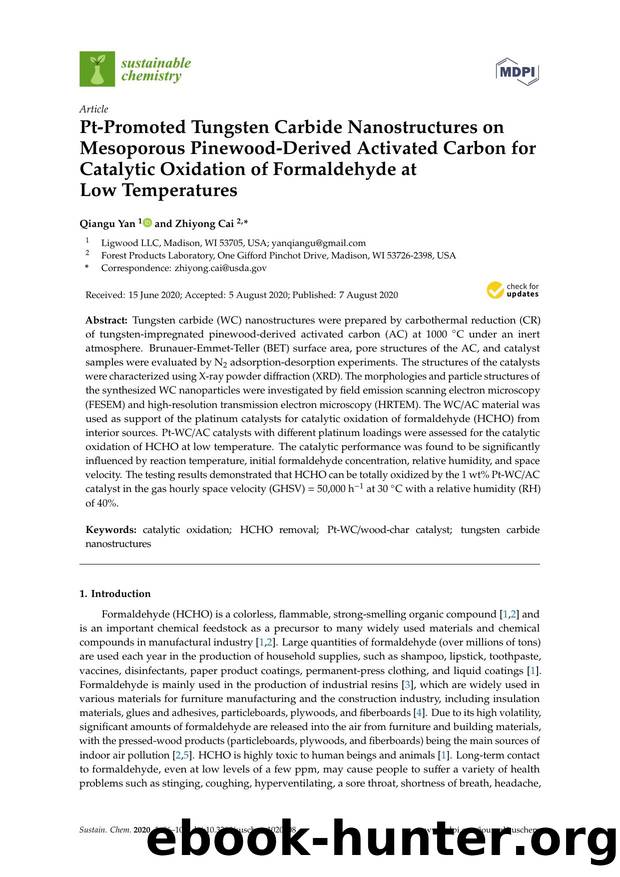Pt-Promoted Tungsten Carbide Nanostructures on Mesoporous Pinewood-Derived Activated Carbon for Catalytic Oxidation of Formaldehyde at Low Temperatures by Qiangu Yan & Zhiyong Cai

Author:Qiangu Yan & Zhiyong Cai
Format: pdf
Tags: Tungsten carbide (WC) nanostructures were prepared by carbothermal reduction (CR) of tungsten-impregnated pinewood-derived activated carbon (AC) at 1000 C under an inert atmosphere. Brunauer-Emmet-Teller (BET) surface area, pore structures of the AC, and catalyst samples were evaluated by N2 adsorption-desorption experiments. The structures of the catalysts were characterized using X-ray powder diffraction (XRD). The morphologies and particle structures of the synthesized WC nanoparticles were investigated by field emission scanning electron microscopy (FESEM) and high-resolution transmission electron microscopy (HRTEM). The WC/AC material was used as support of the platinum catalysts for catalytic oxidation of formaldehyde (HCHO) from interior sources. Pt-WC/AC catalysts with different platinum loadings were assessed for the catalytic oxidation of HCHO at low temperature. The catalytic performance was found to be significantly influenced by reaction temperature, initial formaldehyde concentration, relative humidity, and space velocity. The testing results demonstrated that HCHO can be totally oxidized by the 1 wt% Pt-WC/AC catalyst in the gas hourly space velocity (GHSV) = 50,000 h-1 at 30 C with a relative humidity (RH) of 40%., catalytic oxidation; HCHO removal; Pt-WC/wood-char catalyst; tungsten carbide nanostructures
Download
This site does not store any files on its server. We only index and link to content provided by other sites. Please contact the content providers to delete copyright contents if any and email us, we'll remove relevant links or contents immediately.
What's Done in Darkness by Kayla Perrin(25507)
Shot Through the Heart: DI Grace Fisher 2 by Isabelle Grey(18227)
Shot Through the Heart by Mercy Celeste(18169)
The Fifty Shades Trilogy & Grey by E L James(17783)
The 3rd Cycle of the Betrayed Series Collection: Extremely Controversial Historical Thrillers (Betrayed Series Boxed set) by McCray Carolyn(13197)
The Subtle Art of Not Giving a F*ck by Mark Manson(12924)
Scorched Earth by Nick Kyme(11843)
Stepbrother Stories 2 - 21 Taboo Story Collection (Brother Sister Stepbrother Stepsister Taboo Pseudo Incest Family Virgin Creampie Pregnant Forced Pregnancy Breeding) by Roxi Harding(11062)
Drei Generationen auf dem Jakobsweg by Stein Pia(10223)
Suna by Ziefle Pia(10188)
Scythe by Neal Shusterman(9271)
International Relations from the Global South; Worlds of Difference; First Edition by Arlene B. Tickner & Karen Smith(8625)
Successful Proposal Strategies for Small Businesses: Using Knowledge Management ot Win Govenment, Private Sector, and International Contracts 3rd Edition by Robert Frey(8426)
This is Going to Hurt by Adam Kay(7713)
Dirty Filthy Fix: A Fixed Trilogy Novella by Laurelin Paige(6461)
He Loves Me...KNOT by RC Boldt(5809)
How to Make Love to a Negro Without Getting Tired by Dany LaFerrière(5390)
Interdimensional Brothel by F4U(5312)
Thankful For Her by Alexa Riley(5174)
